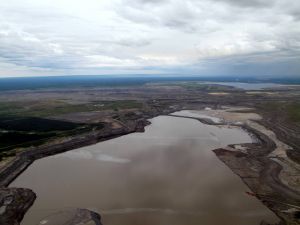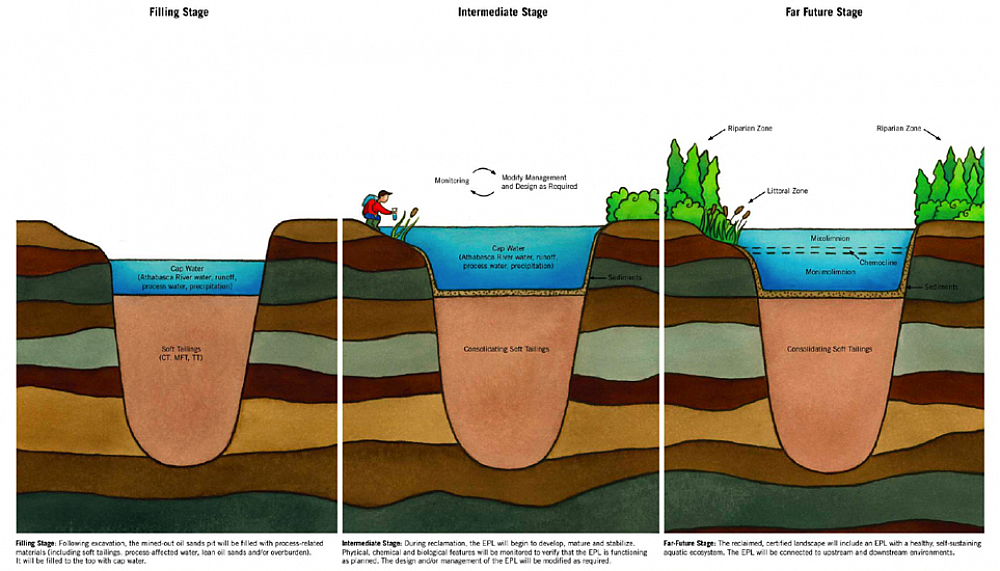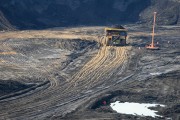At the end of November, Syncrude got the go-ahead to test out its contentious end pit lake proposal to “reclaim” tailings from its oilsands operations by submerging them in the company’s Base Mine Lake. Syncrude, along with a few other oilsands mining operators, intends to cap the toxic tailings waste with fresh water as a permanent solution for tailings reclamation, with the hope that the two layers don’t mix and a self-sustaining aquatic ecosystem forms. According to the Globe and Mail’s cheeky characterization, the plan will either produce Alberta’s very own Lake District featuring nearly 30 lakes created for fishing, boating, and swimming — or it will turn out to be a major misstep, an “industrial experiment gone wrong,” and Alberta could wind up being responsible for a toxic legacy of polluted lakes.
While pit lakes are used in other mining sectors to control water flow when the time comes to close the mine, those lakes are not without their challenges. About half of the 29 end pit lakes proposed by the oilsands industry will have not only water in them, but also a billion cubic metres of tailings waste permanently stored at the bottom, underneath a “cap” of fresh water.
Regulators have approved a number of end pit lakes (subject to demonstration) as suitable and permanent sites for toxic tailings waste, despite the fact that capping tailings with fresh water has never been done before and no end pit lakes currently exist in the oilsands.
Considering that it could take decades to know which way the experiment will go, it seems reckless to bet on such a risky, unproven technology.
Why the gamble?
Currently, storing tailings in an end pit lake is the least costly reclamation option for the oilsands industry. So despite the several unknown long-term monitoring liabilities, salinity concerns, and the chronic toxicity of water that is left over from the oilsands extraction process, companies are allowed to proceed with a cheaper option to dealing with tailings.
End pit lake guidelines recently produced by the Cumulative Environmental Management Association state, “when scientific uncertainty is high and the potential for substantial negative and environmental and/or social impacts exists — a likely scenario for [end pit lakes] — decision-makers and designers should err on the side of caution.” It is noteworthy that Syncrude was a full member of the working group that produced these guidelines, but then was the only member to submit a letter of non-support in regard to the final version of the guidelines. Instead, Syncrude expresses a high level of confidence in the technology and that the Base Mine Lake can work — but we are unaware of what Syncrude is basing this confidence on.
Alternatives to consider
The Pembina Institute has long called for alternatives to using end pit lakes as tailings dump sites. A key way to increase the adoption of less risky technologies is the enforcement of the current tailings rules as well as the creation of new ones. Currently we have tailings rules that only deal with a proportion of future tailings growth, not the legacy tailings that were allowed to accrue for the past 40 years — and it’s the legacy tailings that will likely end up in end pit lakes if Syncrude’s demonstration lake satisfies regulators in the years to come.
 Banking on technologies that are still so technically remote and far off in the future directly counters Alberta’s vision for responsible oilsands development. We see the development of new regulations that encourage the uptake of more tested and timely tailings reclamation options as the responsible path forward. Operators should increase their use of other technologies in development today that can address the tailings mess throughout a mine’s life, rather than at the end of a project — especially since the challenges associated with oilsands tailings continue to grow. Where only 50 square kilometres of tailings lakes were on the landscape six years ago, there are 176 square kilometres today. In 2010, the total volume of fine tailings contained in these lakes was 830 million cubic metres — more than enough to fill 332,000 Olympic-sized swimming pools, one for every household in Quebec City.
Banking on technologies that are still so technically remote and far off in the future directly counters Alberta’s vision for responsible oilsands development. We see the development of new regulations that encourage the uptake of more tested and timely tailings reclamation options as the responsible path forward. Operators should increase their use of other technologies in development today that can address the tailings mess throughout a mine’s life, rather than at the end of a project — especially since the challenges associated with oilsands tailings continue to grow. Where only 50 square kilometres of tailings lakes were on the landscape six years ago, there are 176 square kilometres today. In 2010, the total volume of fine tailings contained in these lakes was 830 million cubic metres — more than enough to fill 332,000 Olympic-sized swimming pools, one for every household in Quebec City.
Given the public interest in knowing the performance of end pit lakes, it is essential that annual data around Syncrude's end pit lake is made widely and freely available and not treated as a proprietary experiment. Should upcoming mining projects be approved, the Lower Athabasca region could host over a dozen open-pit mines with about 30 end pit lakes, all draining to the northward-flowing Athabasca River. It’s no surprise that stakeholders, regulators and Aboriginal groups have expressed concerns about the future performance of end pit lakes, both those with and without tailings at the bottom of them.










